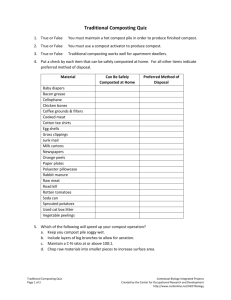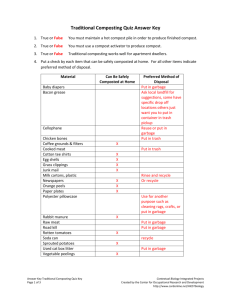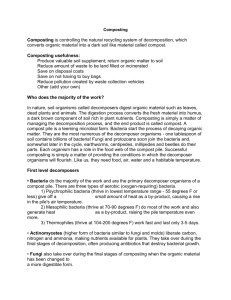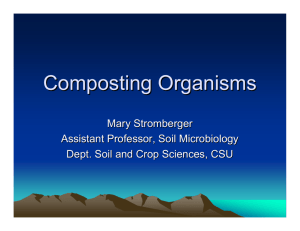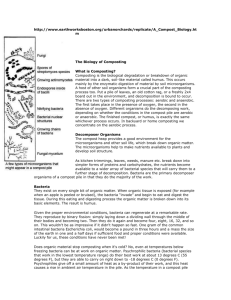Microorgansims Involved in Composting
advertisement
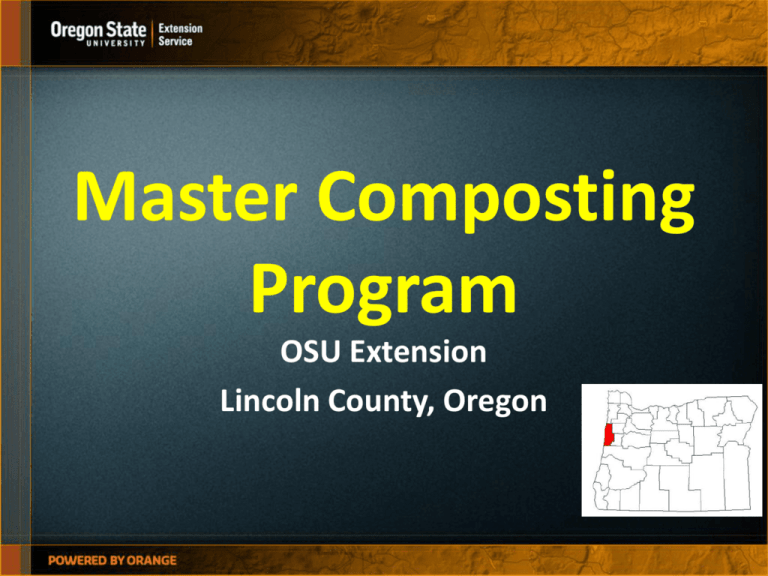
Master Composting Program OSU Extension Lincoln County, Oregon Week Three Microorganism that do the Composting Work Bacteria • Minute single celled organisms – 25,000 laid end to end cover one inch length • 0.035 oz can become 1 pound (16 oz) in just 3 hours • Mass size of the earth in 1 ½ days • Three types of bacteria Psychrophilic Bacteria • Do best at 0- 55oF • Little heat produced • Involved in passive composting Mesophilic Bacteria • 70-90oF • But survive from 40110oF Mesophilic Stage – First real stage of composting – when air, water and C:N Ratios are correct • Lasts 1-2 days – Mesophilic microorganisms break down sugars, fats, starches and proteins releasing heat – Makes the pile become active – Utilize readily available short chained C-pool – Resistant or long carbon chains not affected Thermophilic Bacteria • Work very fast at 104200oF in 3-5 days • Turn green, gold, and tan organic materials into uniform deep brown • Turning the pile restarts this action • Works best at correct C:N ratios Thermophilic Stage • May last several weeks if pile is turned • Temps climb to 120-150 oF • Heat loving (thermophilic) bacteria degrade organic materials • As long as you have oxygen and “digestible organic matter” this stage will remain at 140oF • Particle size reduces, – Pathogens are destroyed above 131 oF, – Fly larvae and weed seeds destroyed at 145oF Anaerobic Bacteria • If pile not turned results in increase in anaerobic bacteria • Less Nitrogen is used but more organic acids (smelly stuff) result Fungi • Most fungi are saprophytes – live on dead or decaying matter • Usually active when compost has cooled using more easily digestible materials Actinomycetes • Described as “half fungal and half bacteria “ • Give compost a pleasant earthy smell • Important in formation of humus • Make nutrients available to plants • Are aerobic Macroorganisms • Nematodes – Roundworms • Fermentation mites • Spring tails • Centipedes, millipedes, wolf spiders, sowbugs, beetles, earthworms • Watch video Worm Bin Creatures Temperature is critical • Decreasing temp indicates low oxygen or moisture • Turn pile to add oxygen • Higher temperatures more than 150-160 kills thermophilic bacteria • Spontaneous combustion can occur at these temperature ranges if pile becomes hot and dries out Moisture is critical • At higher temps of 160oF evaporation occurs rapidly • Re-wet the pile frequently so that moisture content is above 40% • Moisture > 70% reduces oxygen pore space End of Week Three
